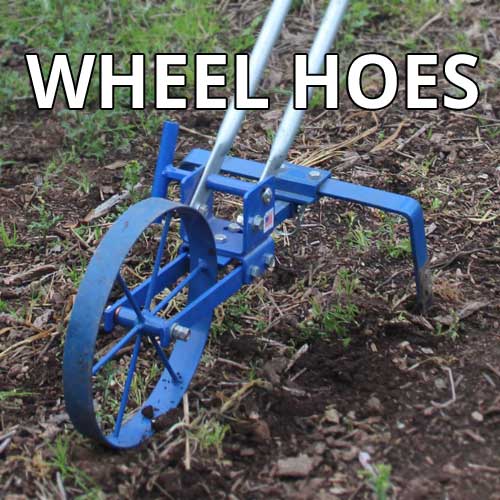Gardening During Drought
Posted by David Grau on
Originally Posted on February 01, 2014
Valentine's Day is just a two weeks away. Certain gardeners and farmers might appreciate the gift of long-lasting, quality tools. Surprise someone with a Wheel Hoe or Broadfork (or both) from Valley Oak Tool Co. They'll think about you every time they use the tools you got them. Combine the gift of tools with some bare-root roses or fruit trees for a very thoughtful gift, and your special someone will think of you for many years.
Gardening During Drought
California is in one of the worst droughts since record-keeping began. We've had such little rain and snow that our reservoirs are low, or drying up altogether. This will likely mean the price of food will be going up, as farmers will have less irrigation water. Taking steps, like mulching, will help conserve water in your own food garden.
Mulch made of organic materials, such as leaves or wood chips, will also help improve the soil as the materials get incorporated into the soil by soil organisms. Last year, we had wood chips from a tree pruning job, and we spread them around the front yard. Recently we felt under the wood chips and the soil was still moist, whereas some of the soil we have in an unplanted part of our trial garden was extremely dry.
When you have mulch around your plants, soil moisture remains available to plants for a longer period of time, thus reducing your need to water as frequently. When Carla planted the garlic in the trial garden, she mulched the plants as soon as the leaves appeared.
 Another approach to mulching is to use a living mulch. Narcissus bulbs planted around an apple tree help shade the base of the tree, (shown in the photo), keep the soil free from weeds, and once the bulbs have finished flowering, the leaves will eventually die back, leaving organic matter that will improve the soil. Mulching is an easy and important step to take in growing your garden with water conservation in mind. We hope you'll give it a try.
Another approach to mulching is to use a living mulch. Narcissus bulbs planted around an apple tree help shade the base of the tree, (shown in the photo), keep the soil free from weeds, and once the bulbs have finished flowering, the leaves will eventually die back, leaving organic matter that will improve the soil. Mulching is an easy and important step to take in growing your garden with water conservation in mind. We hope you'll give it a try.
You can also think about planting drought-tolerant trees and shrubs, such as olives, figs, pomegranates, and rosemary. Planting trees and shrubs (and other perennials) lessens the need for cultivating the soil and all you'll need to do is prune, mulch, and irrigate. Olives are especially wonderful, if you can grow them in your climate, as they are evergreen, drought-tolerant once established, and make fruit that can be preserved in numerous ways.
Figs make a beautiful tree, either in or out of leaf, and the taste of a fresh, ripe fig is a great pleasure in life. Figs are shallow rooted trees that do not need too much fertilizer, and will appreciate a nice layer of mulch around the roots. Birds do tend to find figs as the fruits are ripening, so plan to keep the trees small enough to net, or take other measures to keep the birds away from the fruit. A fig with green fruit (such as the Conadria) will be less attractive to birds than a fig that turns purple when ripe (such as the black mission).
Fig roots are a favorite food of gophers, so installing a wire basket at planting might benefit your tree. We grow several different fig trees in large containers, thus negating the impact of gopher damage. The trees will not get as large, nor fruit as much as those grown in the ground, but they will produce fruit, and what a wonderful reward!
Until next time, happy gardening.


